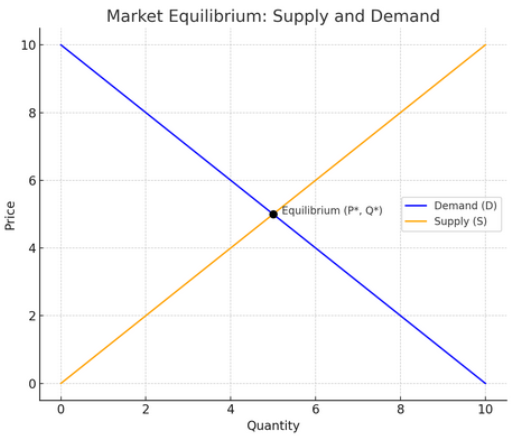Consumer and Producer Surplus
This section explains Consumer and Producer Surplus covering, The Distinction Between Consumer and Producer Surplus, The Use of Supply and Demand Diagrams to Illustrate Consumer and Producer Surplus and How Changes in Supply and Demand Might Affect Consumer and Producer Surplus.
The Distinction Between Consumer and Producer Surplus
Consumer Surplus
Consumer surplus refers to the difference between the price a consumer is willing to pay for a good or service and the price they actually pay. It represents the benefit to consumers from participating in the market. In other words, it is the area between the demand curve and the price level, up to the quantity purchased.
- Example: If a consumer is willing to pay £100 for a good but the market price is £70, the consumer surplus is £30.
Producer Surplus
Producer surplus is the difference between the price a producer receives for a good or service and the minimum price they are willing to accept to produce the good or service. It represents the benefit to producers from participating in the market. It is the area between the supply curve and the price level, up to the quantity sold.
- Example: If a producer is willing to sell a good for £40, but the market price is £70, the producer surplus is £30.
The Use of Supply and Demand Diagrams to Illustrate Consumer and Producer Surplus
To understand consumer and producer surplus, we use supply and demand diagrams, which show the relationship between price and quantity.
- Demand Curve (D): Shows the quantity of a good or service that consumers are willing and able to purchase at various prices.
- Supply Curve (S): Shows the quantity of a good or service that producers are willing and able to produce at various prices.

- The equilibrium price is where the demand curve intersects the supply curve.
- The area above the price level and below the demand curve represents consumer surplus. This is the benefit consumers get from paying less than the price they were willing to pay.
- The area below the price level and above the supply curve represents producer surplus. This is the benefit producers get from receiving more than the minimum price they were willing to accept.
How Changes in Supply and Demand Might Affect Consumer and Producer Surplus
Changes in the market conditions, such as shifts in supply and demand, will affect both consumer and producer surplus. Here are the key impacts:
Changes in Demand:
- Increase in Demand (Shift of the Demand Curve to the Right):
If demand increases, the price tends to rise, which leads to an increase in both consumer surplus (as consumers are willing to pay more) and producer surplus (as producers can sell at higher prices). However, the increase in producer surplus is typically greater than the increase in consumer surplus because of the price rise. - Decrease in Demand (Shift of the Demand Curve to the Left):
If demand decreases, the price falls, leading to a reduction in both consumer surplus (consumers are paying less) and producer surplus (producers receive lower prices). The reduction in producer surplus is typically larger than the reduction in consumer surplus.
Example: If more people want to buy electric cars (an increase in demand), producers can charge a higher price, increasing both consumer and producer surplus, but consumers may lose some of the benefit as prices rise.
Example: A decrease in the popularity of fossil fuel cars may decrease demand for petrol, lowering both consumer and producer surplus.
Changes in Supply:
- Increase in Supply (Shift of the Supply Curve to the Right):
If supply increases, the price tends to fall, which increases consumer surplus (consumers can purchase at lower prices) and increases producer surplus (producers benefit from selling more units at lower prices). However, the consumer surplus increases more than the producer surplus. - Decrease in Supply (Shift of the Supply Curve to the Left):
If supply decreases, the price tends to rise, which results in a reduction in both consumer surplus and producer surplus. However, the consumer surplus decreases more than the producer surplus.
Example: If technology improves and manufacturers can produce more smartphones at a lower cost, the price may fall, leading to greater consumer surplus.
Example: If there is a reduction in the supply of wheat due to poor weather, the price of bread may rise, leading to a decrease in consumer surplus while producers may see some gain from the higher price, although their surplus may be limited due to the overall decrease in quantity supplied.
Combined Effect of Changes in Both Demand and Supply:
If both supply and demand change simultaneously, the effect on surplus depends on the relative magnitude of the shifts in each curve.
- Increase in Both Supply and Demand: If both supply and demand increase, the equilibrium quantity rises, but the price could either rise, fall, or stay the same depending on which shift is larger. Consumer and producer surplus will both increase as the market becomes more efficient.
- Decrease in Both Supply and Demand: If both supply and demand decrease, the equilibrium quantity falls, and the price could either rise, fall, or stay the same depending on the magnitude of the shifts. Both consumer and producer surplus will typically decrease in this case.
Summary
- Consumer surplus is the benefit consumers get from paying less than what they were willing to pay.
- Producer surplus is the benefit producers get from receiving more than what they were willing to accept.
- The equilibrium price is where supply equals demand, and it determines the areas of consumer and producer surplus.
- Shifts in demand or supply affect the price and quantity, and thus the surpluses. An increase in demand or supply tends to increase surpluses, while a decrease in either tends to reduce them.
